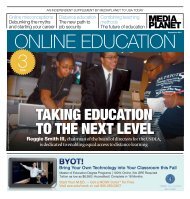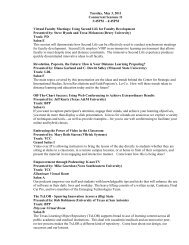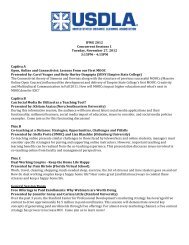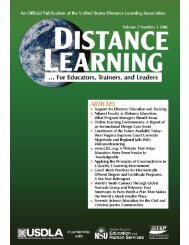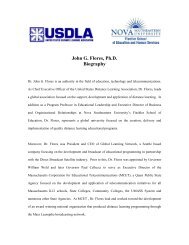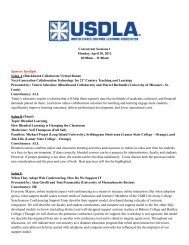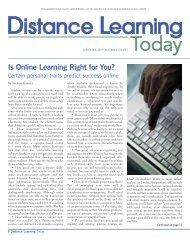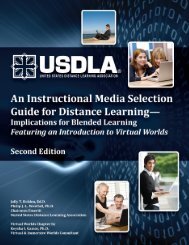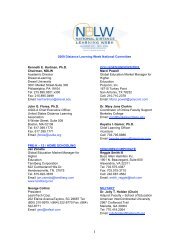United States Distance Learning Association
United States Distance Learning Association
United States Distance Learning Association
- No tags were found...
Create successful ePaper yourself
Turn your PDF publications into a flip-book with our unique Google optimized e-Paper software.
demonstrate, within a set of procedures<br />
and policies, certain actions. Like how you<br />
would tactically move forces to achieve a<br />
mission. And we would think that’s more<br />
training.<br />
So when you look at our programs,<br />
which are basically professional military<br />
education, we look at it as a combination of<br />
both; also, we look at the training aspect as<br />
the doing part, the practical application.<br />
You talk about building something that’s<br />
great theoretically, and that’s all nice stuff.<br />
Do it. So it’s that “do it” part that we see as<br />
the training, because when they do it, we<br />
provide feedback, and show them if<br />
they’re really in error, show them a better<br />
way or a different perspective to get them<br />
to a solution. Because there’s no real solution,<br />
other than a set of procedures to get<br />
you to what we may think is a usable solution.<br />
As a side note—I teach a course at<br />
George Mason University for undergraduates.<br />
It’s a 300 level, and it’s a writingintensive<br />
speech communication course.<br />
Most of them are not real clear on what<br />
creative or critical thinking is, but more<br />
importantly, they’re not real clear on what<br />
a normal essay or paper construct is, like<br />
with an introduction, a middle, and a conclusion.<br />
So we spend a lot more time trying<br />
to get them up to speed because, like<br />
speaking, writing is one of the critical<br />
skills.<br />
And we see the same thing in our<br />
Officer Corps and in our nonresident<br />
courses, and that’s one reason why, as we<br />
get to these questions, we’re moving to a<br />
different type of nonresident, or distance<br />
learning, model because we want them to<br />
be able to demonstrate what they have<br />
learned.<br />
ORNDORFF: And that’s exactly it. It’s<br />
a blend, really, the perfect storm of anybody’s<br />
overall education and training. It’s<br />
not just one or the other. It’s not just in person,<br />
sitting in a classroom, sitting at a computer<br />
taking an online course, or literally<br />
going out and driving the newest version<br />
of a vehicle around. It’s got to be the combination<br />
of them all together, as I see it.<br />
VAN ZUMMEREN: Absolutely! And<br />
therein lies the complexity of nonresident<br />
education. Because it is in trying to find a<br />
balance between what you can do online<br />
and what you want to do in some form of<br />
collaboration. And then again, what’s the<br />
topic If it’s business administration, it’s<br />
one thing. If it’s tactics, it’s another. And if<br />
it’s leadership, another whole different<br />
dynamic of what kind of interaction you’re<br />
actually going to have.<br />
THE CHANGEOVER PROCESS<br />
ORNDORFF: How do the experiences<br />
that you have had with distance learning<br />
in the Marine Corps compare with the<br />
experiences that students have nowadays<br />
with the distance education program<br />
VAN ZUMMEREN: I think prior to<br />
around 1997—that’s when the College of<br />
Continuing Education stood up the seminar<br />
program—the Marine Corps, just like<br />
all the services, tried to do nonresident<br />
education on the cheap. They looked at<br />
those officers who they thought were very<br />
competitive and needed the resident experience<br />
to make them more competitive [for<br />
promotion]; [they] went to the resident<br />
program. And the throughput is sufficient<br />
to sustain itself through our resident<br />
schools to get people into the general<br />
officer ranks.<br />
The problem is, to the Marine Corps, it’s<br />
20% of your population. Eighty percent of<br />
your population does not get the resident<br />
opportunities, so they have to do a nonresident.<br />
As indicated earlier in the conversation,<br />
a box of books with a multiple choice<br />
assessment tool is about as cheap as you<br />
can get. And it’s more of a check in the box.<br />
It’s more about surface information. That’s<br />
what we provided, until we started getting<br />
to 1997, and into a seminar. The biggest<br />
change—first of all, we had to convince the<br />
Marine Corps—we did this in around<br />
2004—is that if the institution is serious<br />
Volume 4, Issue 4 <strong>Distance</strong> <strong>Learning</strong> 89



